
An interesting article by Dan Moreland, Captain and owner of Picton Castle from Sail Training International.


An interesting article by Dan Moreland, Captain and owner of Picton Castle from Sail Training International.
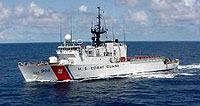
USCG Canned Meat?
I will admit to doing a double take when I saw the USCG press release announcing “Coast Guard Cutter Harriet Lane returns home after 9-week patrol.” I wondered, who would name a ship the Harriet Lane? For the record, the USCGC Harriet Lane was named for Harriet Lane, niece and official hostess of President James Buchanan. The current Harriet Lane is also not the first. There was also a revenue cutter by the same name in 1857.
For those familiar with sailor slang, however, Harriet Lane is also slang for canned meat. Harriet Lane was a murder victim, who was chopped up by her killer around 1875. Merchant sailors came to call any canned meat, Harriet Lane. Fanny Adams, also a long remembered, if also dismembered, murder victim, became Royal Navy slang for tinned meats as well. To the best of my knowledge, there is no USCG Fanny Adams, thank goodness.
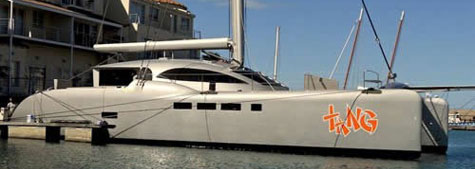
When I had a sailboat, I hated motoring. The diesel was loud and vibrated, completely different from why I went out sailing in the first place. Tag Yachts in South Africa, in partnership with Electric Marine Propulsion and International Battery, may have solved the problem in their new 60-foot catamaran named Tang. When not under sail, the boat is powered by electric motors. When sailing the propellers are turned by the boat’s wake and recharge the batteries. There are also twin diesel generators to recharge the batteries when not under sail or on shore power. The catamaran is built of carbon fiber. The owner plans on sailing the boat to Florida and to make an appearance at the Miami Boat show in February.
Wind-generated electricity powers 60 foot hybrid-electric catamaran
 This week 1,000 Royal Navy Medical Officer Journals were made available to the public at the British National Archives in Kew. The journals are revealing, if often disturbing by modern standards. From drunken mutinies to disease outbreaks to a walrus attack, the journals paint a colorful picture of 18th- and 19th-century ship life.
This week 1,000 Royal Navy Medical Officer Journals were made available to the public at the British National Archives in Kew. The journals are revealing, if often disturbing by modern standards. From drunken mutinies to disease outbreaks to a walrus attack, the journals paint a colorful picture of 18th- and 19th-century ship life.
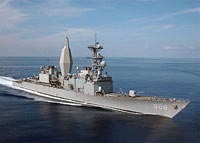
USS Arthur W. Radford
Perhaps not a case of swords into plowshares, but at least a destroyer into an artificial reef. In November, the 535 foot decommissioned Navy destroyer, USS Arthur W. Radford, will sink beneath the waters off Cape May Point to become the longest vessel ever turned into an East Coast artificial reef.
Destroyer Arthur W. Radford to become reef off New Jersey coast
Continue reading

Coffee House by Hogarth
Happy National Coffee Day! I don’t know who decided that today was National Coffee Day, nor even why we should necessarily be celebrating it. However, as a confirmed and happily contented coffee addict, perhaps this is a good time to reflect on coffee, ships and shipping.
Coffee may have had a far greater impact on shipping than even, dare say it, rum. The first English coffee houses sprang up in London around 1650. Edward Lloyd started Lloyd’s coffee house on Tower Street in 1668.
Continue reading
 Given all the reporting on piracy off the Horn of Africa, we hear very little about another crisis – the flood of refugees fleeing the instability and chaos of Somalia’s clan wars. Last year 74,000 people crossed the Gulf of Aden in smugglers’ boats to reach Yemen, according to the UN refugee agency UNHCR.
Given all the reporting on piracy off the Horn of Africa, we hear very little about another crisis – the flood of refugees fleeing the instability and chaos of Somalia’s clan wars. Last year 74,000 people crossed the Gulf of Aden in smugglers’ boats to reach Yemen, according to the UN refugee agency UNHCR.
On Monday the USS Winston S. Churchill attempted to render aid to an overloaded skiff drifting in the Gulf of Aden with 85 refugees from Somalia and Ethiopia. The skiff’s engine had broken down. According to a statement released by the Navy:
Continue reading
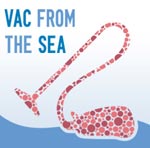 Yesterday we posted that scientists are not sure where all the plastic floating in the vast Atlantic and Pacific garbage patches is going. Sadly, the answer is probably not that a big vacuum cleaner is vacuuming the stuff up to recycle it. Nevertheless, here is a great story about Electrolux, which is facing, believe it or not, a shortage of recycled plastic with which to make vacuum cleaners. Electrolux has launching its ‘Vac from the Sea’ initiative to gather plastic from the ocean and along the shoreline and to turn that plastic into vacuum cleaners.
Yesterday we posted that scientists are not sure where all the plastic floating in the vast Atlantic and Pacific garbage patches is going. Sadly, the answer is probably not that a big vacuum cleaner is vacuuming the stuff up to recycle it. Nevertheless, here is a great story about Electrolux, which is facing, believe it or not, a shortage of recycled plastic with which to make vacuum cleaners. Electrolux has launching its ‘Vac from the Sea’ initiative to gather plastic from the ocean and along the shoreline and to turn that plastic into vacuum cleaners.
Continue reading
The Mariners Museum in Newport News, VA has a new exhibition: Endangered Species – Watermen of the Chesapeake, featuring extraordinary B & W portraits of watermen who work the waters of the Chesapeake Bay. For those of us not in the area, the website includes photography and video of the waterman, including clips from “The Last Boat Out,” a documentary about waterman on the Chesapeake which aired on PBS last spring.
“The Last Boat Out” PBS Opening Sequence from Seltzer Film & Video on Vimeo.
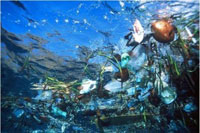 We have previously posted about the plastic “garbage patches” in both the Atlantic and Pacific Oceans – great current vortexes where floating plastic trash has accumulated. As reported in Scientific American scientists studying the garbage patches have noticed that despite that their size has stayed relatively constant despite an steady influx of plastic into the oceans, raising the question “where is all the plastic going?” It may be breaking up into smaller pieces and/or sinking or it may be being easting by marine life and entering the the food chain. The best answer is that no one knows.
We have previously posted about the plastic “garbage patches” in both the Atlantic and Pacific Oceans – great current vortexes where floating plastic trash has accumulated. As reported in Scientific American scientists studying the garbage patches have noticed that despite that their size has stayed relatively constant despite an steady influx of plastic into the oceans, raising the question “where is all the plastic going?” It may be breaking up into smaller pieces and/or sinking or it may be being easting by marine life and entering the the food chain. The best answer is that no one knows.
Ocean garbage patches are not growing, so where is all that plastic going?
Continue reading
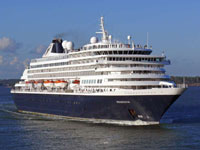
Prinsendam
Passengers should embark and disembark by the gangway only. Three stories, two of them tragic, of unusual arrivals and departures from cruise ships last week.
On the Holland America cruise ship, Prinsendam, passengers were shocked when a powered hang glider made a crash landing on the upper deck while the ship was docked in Portimao last week. The 25-year-old Brazilian pilot suffered a broken leg.
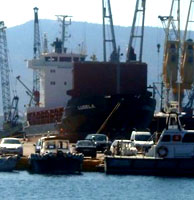
Photo: T. Michalis - MarineTraffic.com
Well planned passive resistance proved to be an effective tactic for the crew of the MV Lugela this weekend. Earlier this month we posted about the hijacking and subsequent recapture of the M/V Magellan Star from Somali pirates by US Marine commandos, after the crew had disabled the engine and hid in a safe room. On Saturday, 900 miles off the cost of Somalia, pirates attacked the MV Lugela, a 4,000 dwt cargo ship with a Ukranian crew. In accordance with a prepared response plan, the crew locked themselves in the engine room with stocks of food and water, after disabling the helm and other bridge controls. After failing to gain access to either the crew or the engine room, the pirates have reportedly given up and left the ship, allowing the crew to regain full control.
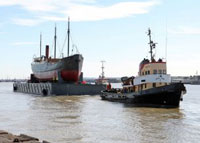
'SS Robin' arrives at the UK port of Tilbury on Saturday. Photo: Andy Howes
An update on our post from last June on the SS Robin, an 1890 built steam coaster, the last of her kind and the oldest complete steamship in the world. She arrived in Tillbury last week aboard a a custom built pontoon barge in time to celebrate her 120th birthday.
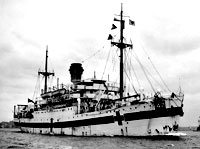 The Australian Hospital Ship Centaur was torpedoed by a Japanese submarine off the coast of Queensland, Australia, on 14 May 1943. Of the 332 medical personnel and civilian crew aboard, 268 were killed. The exact position of the sunken ship was unknown until December of last year when the ship wreck was positively identified. On Friday, an at-sea memorial service was held aboard the HMAS Manoora over the site of the sunken ship.
The Australian Hospital Ship Centaur was torpedoed by a Japanese submarine off the coast of Queensland, Australia, on 14 May 1943. Of the 332 medical personnel and civilian crew aboard, 268 were killed. The exact position of the sunken ship was unknown until December of last year when the ship wreck was positively identified. On Friday, an at-sea memorial service was held aboard the HMAS Manoora over the site of the sunken ship.
After 67 years, ‘cloud of sorrow’ is finally lifted
Continue reading
 This sounds completely nuts. It might possibly work but there is the question of scale to be addressed. Hurricanes, or typhoons in the Pacific, need warm water to provide energy to the storm. The idea is to built a fleet of submarines to dive in the path of a typhoon and pump cold water to the surface to deprive the storm of its source of power. (I’m not making this up.)
This sounds completely nuts. It might possibly work but there is the question of scale to be addressed. Hurricanes, or typhoons in the Pacific, need warm water to provide energy to the storm. The idea is to built a fleet of submarines to dive in the path of a typhoon and pump cold water to the surface to deprive the storm of its source of power. (I’m not making this up.)
Inventor creates ‘submarine’ to block typhoons
Continue reading
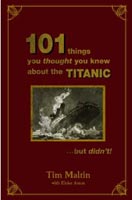 In light of the recent claims in Louise Patten’s new book, Good as Gold , which we posted about earlier this week, we are very pleased to welcome Tim Maltin, author of 101 Things You Thought You Knew About the Titanic…But Didn’t, as guest blogger, to provide his perspective regarding the legendary and apparently, often mythical, ship.
In light of the recent claims in Louise Patten’s new book, Good as Gold , which we posted about earlier this week, we are very pleased to welcome Tim Maltin, author of 101 Things You Thought You Knew About the Titanic…But Didn’t, as guest blogger, to provide his perspective regarding the legendary and apparently, often mythical, ship.
The sinking of the Titanic is one of the best documented disasters in history. In 1912, this catastrophe was the subject of detailed public enquiries on both sides of the Atlantic. During these full hearings, more than 50,000 questions were asked of more than 100 eye-witnesses. All of their answers were recorded, in full, and published generally, as well as kept in libraries up and down the country. And yet what most of us knows about the sinking of the Titanic today is a far cry from what actually happened that night, when 1,500 people froze to death in the North Atlantic.
Continue reading

Fairport Harbor West Breakwater Light
In September 2009, the United States General Services Administration put the Fairport Harbor West Breakwater Light, on Lake Erie, up for public auction via an online auction. The minimum bid is $10,000 with incremental bids of $5,000 required. The bidding was supposed to end yesterday but is still ongoing and may roll-over until Monday at 3PM. The highest bid is now $42,000. The Fairport Harbor-west breakwater — also known as the Grand River-west breakwater lighthouse — is adjacent to Headlands Beach State Park/Headlands Dunes State Nature Preserve.
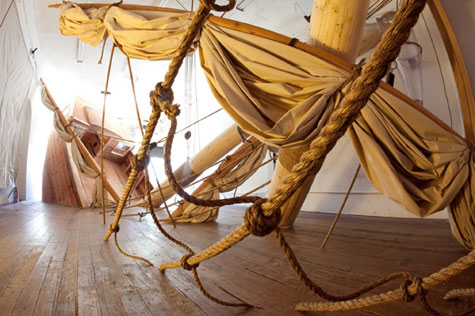
Artist Josh Beckman’s “Sea Nymph” in LA’s Machine Project gallery is nothing less that a shipwreck in an art gallery. To accompany the installation, the gallery has hosted a series of nautical-themed events, performances, lectures, and workshops, as well as an opera by and for dogs. Sea-dogs, we hope. The exhibition continues through October 8th.
 The brig Prince William owned by the Tall Ships Youth Trust has been sold to the Pakistan Navy and has been renamed the PNS Rah Naward. The Prince William was delivered in 2001, a sistership to the TS Stavros S. Niarchos. The Prince William was laid up in 2007 and has been actively for sale. The sale was announced by a the Tall Ships Youth Trust in letter dated September 22 but posted on their website this morning. In addition to the Stavros S. Niarchos, the Trust also operates four identical 22 m Challenger yachts and a 19 metre catamaran.
The brig Prince William owned by the Tall Ships Youth Trust has been sold to the Pakistan Navy and has been renamed the PNS Rah Naward. The Prince William was delivered in 2001, a sistership to the TS Stavros S. Niarchos. The Prince William was laid up in 2007 and has been actively for sale. The sale was announced by a the Tall Ships Youth Trust in letter dated September 22 but posted on their website this morning. In addition to the Stavros S. Niarchos, the Trust also operates four identical 22 m Challenger yachts and a 19 metre catamaran.
Off Kent, in the UK, the world’s biggest offshore wind farm has been officially opened. With 100 turbines, the Thanet project is expected to generate enough electricity to power 200,000 homes. Currently the UK gets 3% of all its energy from renewable sources. It is aiming to reach 15% by 2020.
Of the top 25 offshore wind farms in the world today, 24 are in the European Union. One is in China. The US has no operational offshore wind farms. Cape Wind, the proposed wind farm closest to fruition in the US, is still the subject of controversy and partisan politcs. Thanks to Alaric Bond for passing the article along.